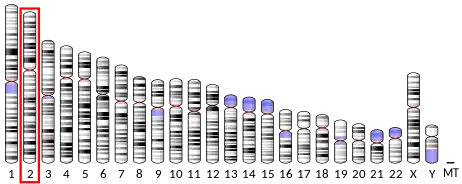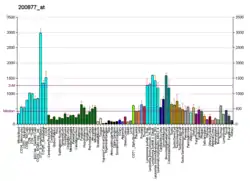T-complex protein 1 subunit delta is a protein that in humans is encoded by the CCT4 gene.[5][6] The CCT4 protein is a component of the TRiC complex.
Interactions
References
- 1 2 3 GRCh38: Ensembl release 89: ENSG00000115484 - Ensembl, May 2017
- 1 2 3 GRCm38: Ensembl release 89: ENSMUSG00000007739 - Ensembl, May 2017
- ↑ "Human PubMed Reference:". National Center for Biotechnology Information, U.S. National Library of Medicine.
- ↑ "Mouse PubMed Reference:". National Center for Biotechnology Information, U.S. National Library of Medicine.
- ↑ Won KA, Schumacher RJ, Farr GW, Horwich AL, Reed SI (Dec 1998). "Maturation of human cyclin E requires the function of eukaryotic chaperonin CCT". Molecular and Cellular Biology. 18 (12): 7584–9. doi:10.1128/mcb.18.12.7584. PMC 109339. PMID 9819444.
- ↑ "Entrez Gene: CCT4 chaperonin containing TCP1, subunit 4 (delta)".
- ↑ Chen GI, Tisayakorn S, Jorgensen C, D'Ambrosio LM, Goudreault M, Gingras AC (Oct 2008). "PP4R4/KIAA1622 forms a novel stable cytosolic complex with phosphoprotein phosphatase 4". The Journal of Biological Chemistry. 283 (43): 29273–84. doi:10.1074/jbc.M803443200. PMC 2662017. PMID 18715871.
- ↑ Gingras AC, Caballero M, Zarske M, Sanchez A, Hazbun TR, Fields S, Sonenberg N, Hafen E, Raught B, Aebersold R (November 2005). "A novel, evolutionarily conserved protein phosphatase complex involved in cisplatin sensitivity". Molecular & Cellular Proteomics. 4 (11): 1725–40. doi:10.1074/mcp.M500231-MCP200. PMID 16085932. S2CID 7531012.
External links
- Human CCT4 genome location and CCT4 gene details page in the UCSC Genome Browser.
Further reading
- Kubota H, Hynes G, Carne A, Ashworth A, Willison K (Feb 1994). "Identification of six Tcp-1-related genes encoding divergent subunits of the TCP-1-containing chaperonin". Current Biology. 4 (2): 89–99. doi:10.1016/S0960-9822(94)00024-2. PMID 7953530. S2CID 31300131.
- Wu-Baer F, Lane WS, Gaynor RB (Feb 1996). "Identification of a group of cellular cofactors that stimulate the binding of RNA polymerase II and TRP-185 to human immunodeficiency virus 1 TAR RNA". The Journal of Biological Chemistry. 271 (8): 4201–8. doi:10.1074/jbc.271.8.4201. PMID 8626763.
- Nabetani A, Hatada I, Morisaki H, Mukai T (June 1996). "Chromosomal assignment and imprinting tests for the mouse delta subunit of the cytosolic chaperonin containing TCP-1 (Cct4) gene to proximal chromosome 11". Genomics. 34 (2): 246–9. doi:10.1006/geno.1996.0276. PMID 8661059.
- Melki R, Batelier G, Soulié S, Williams RC (May 1997). "Cytoplasmic chaperonin containing TCP-1: structural and functional characterization". Biochemistry. 36 (19): 5817–26. doi:10.1021/bi962830o. PMID 9153422.
- Llorca O, McCormack EA, Hynes G, Grantham J, Cordell J, Carrascosa JL, Willison KR, Fernandez JJ, Valpuesta JM (December 1999). "Eukaryotic type II chaperonin CCT interacts with actin through specific subunits". Nature. 402 (6762): 693–6. Bibcode:1999Natur.402..693L. doi:10.1038/45294. PMID 10604479. S2CID 4421057.
- Llorca O, Martín-Benito J, Gómez-Puertas P, Ritco-Vonsovici M, Willison KR, Carrascosa JL, Valpuesta JM (August 2001). "Analysis of the interaction between the eukaryotic chaperonin CCT and its substrates actin and tubulin". Journal of Structural Biology. 135 (2): 205–18. doi:10.1006/jsbi.2001.4359. PMID 11580270.
- Parissi V, Calmels C, De Soultrait VR, Caumont A, Fournier M, Chaignepain S, Litvak S (Dec 2001). "Functional interactions of human immunodeficiency virus type 1 integrase with human and yeast HSP60". Journal of Virology. 75 (23): 11344–53. doi:10.1128/JVI.75.23.11344-11353.2001. PMC 114720. PMID 11689615.
- Gevaert K, Goethals M, Martens L, Van Damme J, Staes A, Thomas GR, Vandekerckhove J (May 2003). "Exploring proteomes and analyzing protein processing by mass spectrometric identification of sorted N-terminal peptides". Nature Biotechnology. 21 (5): 566–9. doi:10.1038/nbt810. PMID 12665801. S2CID 23783563.
- Imai Y, Soda M, Murakami T, Shoji M, Abe K, Takahashi R (December 2003). "A product of the human gene adjacent to parkin is a component of Lewy bodies and suppresses Pael receptor-induced cell death". The Journal of Biological Chemistry. 278 (51): 51901–10. doi:10.1074/jbc.M309655200. PMID 14532270.
- Kimura K, Wakamatsu A, Suzuki Y, Ota T, Nishikawa T, Yamashita R, Yamamoto J, Sekine M, Tsuritani K, Wakaguri H, Ishii S, Sugiyama T, Saito K, Isono Y, Irie R, Kushida N, Yoneyama T, Otsuka R, Kanda K, Yokoi T, Kondo H, Wagatsuma M, Murakawa K, Ishida S, Ishibashi T, Takahashi-Fujii A, Tanase T, Nagai K, Kikuchi H, Nakai K, Isogai T, Sugano S (Jan 2006). "Diversification of transcriptional modulation: large-scale identification and characterization of putative alternative promoters of human genes". Genome Research. 16 (1): 55–65. doi:10.1101/gr.4039406. PMC 1356129. PMID 16344560.
- Chi A, Valencia JC, Hu ZZ, Watabe H, Yamaguchi H, Mangini NJ, Huang H, Canfield VA, Cheng KC, Yang F, Abe R, Yamagishi S, Shabanowitz J, Hearing VJ, Wu C, Appella E, Hunt DF (November 2006). "Proteomic and bioinformatic characterization of the biogenesis and function of melanosomes". Journal of Proteome Research. 5 (11): 3135–44. doi:10.1021/pr060363j. PMID 17081065.
This article is issued from Wikipedia. The text is licensed under Creative Commons - Attribution - Sharealike. Additional terms may apply for the media files.




